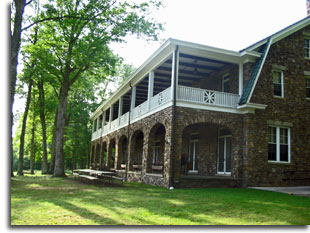Woodmont History
 Organized in 1870 as a premiere hunting club, Woodmont was in continuous operation for almost 125 years. The original owners of the property were wealthy and influential businessmen from Washington who enjoyed the abundant opportunities to pursue wild game. Woodmont Rod and Gun Club was formed shortly after the purchase of the land. Woodmont continued to be a retreat for the powerful men of Washington, DC for many years until the clubhouse and all its records burned in 1903. Following this incident, the original club dissolved and they decided to sell the land.
Organized in 1870 as a premiere hunting club, Woodmont was in continuous operation for almost 125 years. The original owners of the property were wealthy and influential businessmen from Washington who enjoyed the abundant opportunities to pursue wild game. Woodmont Rod and Gun Club was formed shortly after the purchase of the land. Woodmont continued to be a retreat for the powerful men of Washington, DC for many years until the clubhouse and all its records burned in 1903. Following this incident, the original club dissolved and they decided to sell the land.
In 1908, Henry Bridges, a lawyer and successful businessman from Hancock, organized a group of wealthy friends who were sportsmen, and purchased the land. The club became “The Woodmont Rod and Gun Club of Baltimore City,” and Henry Bridges became the secretary-treasurer. In its first year, a clubhouse was built under Bridge’s direction. In 1930, this building was replaced by a massive three-story fieldstone structure still in use today. Massive beams, wood paneling and floors, and huge stone fireplaces formed an appropriate background for more than six-hundred game trophies around the building. The upstairs held numerous bedrooms for members to use during their visits. Great leather chairs, bear skin rugs, and photographs of special guests did and still do fill the rooms today.
Henry Bridges created a wildlife haven at Woodmont. Bridges started a wild turkey breeding program, using the old clubhouse as the center of operations. In addition to turkeys, Bridges imported large white-tailed deer from Michigan to breed with the smaller, resident deer. This produced a larger, Woodmont variety, which stayed primarily within the confines of the Woodmont preserve because of a nine foot high fence erected around the preserve.
Henry Bridges died in 1957. The responsibility of managing the Club fell to E.T. Andrews, a major shareholder in the non-profit corporation. Since that time, the breeding programs have been continued and expanded to include several varieties of pheasant. Forest management plans also were placed under effect.
In 1986, Henry Roemer became the resident manager until 1995, when the Maryland Department of Natural Resources and Izzak Walton League of America purchased Woodmont.Currently, Woodmont is managed as a cooperative effort under the Fort Frederick State Park Complex and the Maryland Wildlife & Heritage Service.
Several special events are held at the Lodge and on the property April through September. For more information, contact Fort Frederick State Park at (301) 842-2155.